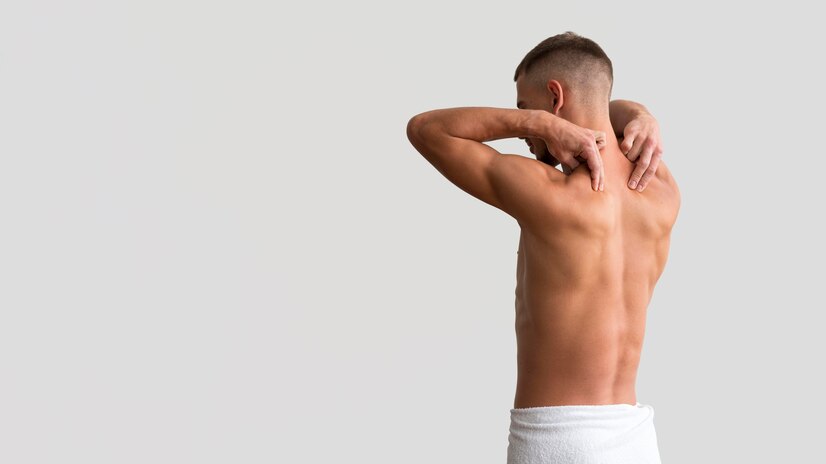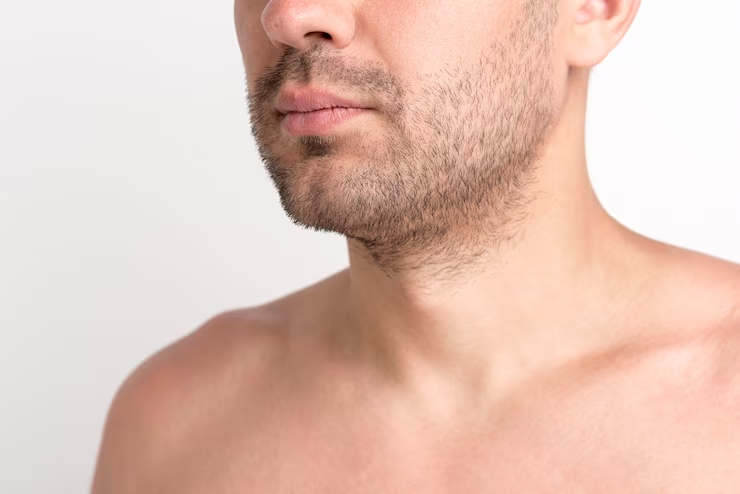
Acne is a common condition that affects people of all ages. Acne is most common on the face but can also affect other body parts, including the back. Like all acne, back acne occurs due to overactive sebaceous glands. These glands produce too much sebum, leading to growth of bacteria and dead skin cells that block the pores (hair follicles) of your skin.
When acne occurs on your back, it can be more challenging to treat than facial acne because it's harder to see and reach. Even if you have acne on your back, it's essential to treat it right away—acne often leaves scars that are difficult to cover up with makeup or clothing. Back acne scars are visible when you are shirtless, wear backless clothing or go for a swim.
If you’re curious about how to get rid of back acne scars, there are plenty of ways you can try so that they fade away quickly! This article will explain what causes back acne, how to treat it, and how to prevent it from happening again.
What is Back Acne?
Back acne is also called "bacne" and is a common skin condition. It is caused by a buildup of dead skin cells and oil on your body's surface. This buildup can block skin pores and lead to inflammation, redness, and sometimes even pimples on your upper back.
The main difference between back acne and other types is that it tends to be more stubborn and difficult to treat. This is because it's harder for people to reach their backs with their hands, so dirt and oils build up there without being washed away as frequently as on other parts of the body.
Back acne can also be caused by wearing tight or restrictive clothing that rubs against the skin, which can irritate existing blemishes or make them worse.
Causes of Back Acne
Hormones
Hormones are a significant cause of back acne. The hormone testosterone can increase oil production in your skin, leading to acne. It's not just teenage boys undergoing puberty who should be concerned about their hormones, though—even adults can experience back acne due to hormonal changes.
Family history
Family history is one of the biggest risk factors for back acne. Genetics play a role in developing acne. If you have a parent or sibling suffering from this condition, you are at a higher risk of developing it yourself.
Friction
One of the most common causes of back acne is friction. Clothing, tight collars or backpacks that rub against your skin can cause a breakout on your back. This includes things like tight jeans, too-short shorts, and tank tops with straps that don't go far enough down your shoulders.
Certain medications
Corticosteroids, often taken to reduce inflammation and swelling, can cause acne on any body part. Still, they are especially likely to cause acne on the back.
Poor hygiene
If you don't wash properly, dirt and grease will build up on your skin, making it more likely to get infected by bacteria and causing back acne. Another way poor hygiene can lead to back acne is if you use dirty towels or sheets when you shower or get changed. This can spread germs from one part of your body to another.
Stress
While stress and anxiety are not the only cause of back acne, they are significant in creating pimples on your back. When you're stressed, your body releases cortisol, which causes your sebaceous glands to produce more oil. If you don't take good care of your skin, the excess oil can clog up pores and cause breakouts.
Sweat
Sweat is one of the main causes of back acne. Sweat tends to build up in the pores, but if you don't wash it out, it can cause breakouts. To prevent this from happening, shower at least once a day and use a good exfoliator once or twice a week on your back.
Using oily skin and hair products can also cause back acne.
Symptoms of Back Acne
Back acne can come in various forms and affect people in different ways. The symptoms of back acne can include:
Papules
- Red inflamed bumps. These can be tender to touchPustules
or pimples - papules with pus in their tipsNodules
are hard lumps under the skin that can be painful to touch and may take months to heal.Cysts
are deep pus filled lumps under the skin and can be painful and hard to treat. They may not go away on their own and need medical treatment.Whiteheads
or closed comedones. They appear as small white bumps on your skin, which can irritate if touched or rubbed by clothing. If the pore remains clogged when it opens, oxidation can occur leading to black heads.Blackheads
or open comedones are open blocked pores that have turned blackish due to keratin oxidation within hair follicles in the skin surface layer of your back (epidermis).Pitted skin or acne scars or even
keloids
(thick scars) can remain for long periods even after acne has healed.Back acne can give you back pain and tenderness, especially if there are nodules and infected cysts.
How to Get Rid of Back Acne Scars
The best way to treat back acne scars is to use a combination of topical treatments and lasers. If you're looking for a way to treat back acne scars, there are several treatment options available such as:
Chemical peels
Another option to treat back acne scars is LED treatment. This involves using light energy to help stimulate collagen production, which can help reduce the appearance of your scars. The process involves using light therapy on your skin, which will help stimulate collagen production, reducing scarring over time.
Micro or nano needling uses needles instead of lasers or other devices to create a controlled injury in the skin. When this wound heals over time, it will produce new collagen, which helps reduce scarring by filling in sunken areas on your back where acne scars may have formed over time. Dermabrasion - remove surface layers of skin to reduce acne scars
Prescription medications
are available to treat back acne scars. These include topical retinoids, benzoyl peroxide creams and gels, oral antibiotics, and oral isotretinoin (Accutane). If you decide to use a prescription medication for your back acne scarring, it's essential to be aware of the potential side effects of each treatment.The treatment of back acne scars is a multi-step process. The first thing you should do is find a dermatologist who can help you with the best treatment options for your particular skin type and the severity of your acne scars.
Home Remedies for Back Acne Scars
Honey
Honey is an excellent home remedy for back acne scars. Honey has been used for centuries as a natural remedy for wounds and infections because of its antibacterial properties. It's used for many different purposes, including speeding up wound healing and reducing the appearance of scars.
Aloe vera
According to a study, applying directly to wounds reduced inflammation and the size of the scar. The gel from aloe vera leaves is a powerful antioxidant that helps to undo the damage caused by free radicals. It is also full of vitamins and minerals that promote healthy skin cells. Applying aloe vera directly to your back acne scars can help reduce inflammation, promote healing, and lighten dark spots.
Black seed oil
Black seed oil has anti-inflammatory properties, which means it can help to minimize the redness that often accompanies acne and post-acne scarring. Studies show that it can speed up and improve wound healing, which can be especially helpful when trying to fade the appearance of scars on your back.
Rosehip oil
Rosehip seed oil is one of the best natural remedies for treating back acne scars. This oil has been shown to reduce the appearance of scars and help prevent new ones from forming. One study indicated that rosehip seed oil helped reduce surgical scars, but there's some evidence that it can also be used for acne scars on the face or body.
Diet and Lifestyle Changes to Prevent Back Acne

While you can't eliminate your risk of developing back acne, there are ways to reduce it. The best way to do this is by making simple changes to your diet and lifestyle.
Cut down on junk food and sweets
Junk food tends to have a lot of sugar which can cause inflammation in the body. Sweets also have a lot of sugar which can cause inflammation and acne breakouts because they contain high amounts of refined carbs that spike blood sugar levels causing imbalanced insulin levels which trigger cell growth (causing pimples). Research has shown that consuming carbohydrate rich foods like bread, bagels, and chips can worsen acne.
Instead, try eating whole grains such as quinoa or brown rice, which both contain fiber that helps stabilize blood sugar levels preventing spikes that promote acne breakouts and providing many other health benefits!
No alcohol & smoke
You should also avoid smoking or drinking alcohol if you have acne on your back or chest area because both substances cause blood vessels to dilate (expand), leading to more inflammation in the area where they were consumed (which means more breakouts).
Proper hygiene
You should also avoid wearing tight-fitting clothing that could trap sweat against your skin, which can cause breakouts. Showering after workouts can also help prevent back acne scars by preventing sweat from pooling on your back and irritating the skin.
No harsh exfoliants
Use gentle cleansers on your back that prevent irritation. Avoid harsh scrubs that can irritate your skin further by causing excess oil production or irritation from scrubbing too hard with a washcloth. If you want to exfoliate your skin regularly without causing further damage, try using products that contain gentle exfoliating agents such as glycolic or jojoba beads.
Cotton material is good for workout clothes because it wicks away moisture. (the fabric is non absorbent, therefore the sweat and moisture will move to outer layer of the fabric and will dry soon) Avoid stress as much as possible. You can practice yoga and meditation to calm yourself.
Conclusion
The best way to prevent back acne scars is to avoid them in the first place. If you are diligent about keeping your back clean and dry, you can avoid most problems. However, if you find yourself with a breakout on your back, there are several things that you can do to treat it and prevent it from getting worse.
Use salicylic acid or benzoyl peroxide products to treat the acne and prevent scarring. You should also avoid using products that contain heavy fragrances, alcohol, or other ingredients that can irritate your skin. Avoid wearing tight clothing that could chafe your skin and irritate any existing acne.
And lastly, the best way to keep your back acne scars from worsening is to stop picking at them! If you're still experiencing back acne scars after trying these tips, consider visiting a dermatologist or plastic surgeon who can help you determine whether they can be treated with lasers or surgery.









